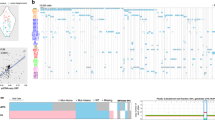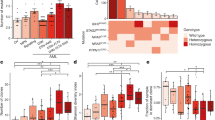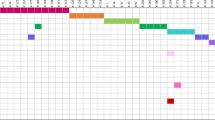Abstract
Acute myeloid leukemia (AML) has a poor prognosis and a heterogeneous mutation landscape. Although common mutations are well-studied, little research has characterized how the sequence of mutations relates to clinical features. Using published, single-cell DNA sequencing data from three institutions, we compared clonal evolution patterns in AML to patient characteristics, disease phenotype, and outcomes. Mutation trees, which represent the order of select mutations, were created for 207 patients from targeted panel sequencing data using 1 639 162 cells, 823 mutations, and 275 samples. In 224 distinct orderings of mutated genes, mutations related to DNA methylation typically preceded those related to cell signaling, but signaling-first cases did occur, and had higher peripheral cell counts, increased signaling mutation homozygosity, and younger patient age. Serial sample analysis suggested that NPM1 and DNA methylation mutations provide an advantage to signaling mutations in AML. Interestingly, WT1 mutation evolution shared features with signaling mutations, such as WT1-early being proliferative and occurring in younger individuals, trends that remained in multivariable regression. Some mutation orderings had a worse prognosis, but this was mediated by unfavorable mutations, not mutation order. These findings add a dimension to the mutation landscape of AML, identifying uncommon patterns of leukemogenesis and shedding light on heterogeneous phenotypes.
This is a preview of subscription content, access via your institution
Access options
Subscribe to this journal
Receive 12 print issues and online access
$259.00 per year
only $21.58 per issue
Buy this article
- Purchase on Springer Link
- Instant access to full article PDF
Prices may be subject to local taxes which are calculated during checkout






Similar content being viewed by others
Data availability
Genomic data that were created for this study are available on dbGaP with accession phs002049.v1.p1 and on Sequence Read Archive with NCBI BioProject ID PRJNA648656. Data from Stanford are being submitted to dbGaP. Clinical data are available on request.
Code availability
Code and trees are available on Github at https://github.com/mattschwede/aml-mutation-order.
References
SEER. Acute myeloid leukemia - cancer stat facts. https://seer.cancer.gov/statfacts/html/amyl.html. 2023.
Klco JM, Spencer DH, Miller CA, Griffith M, Lamprecht TL, O’Laughlin M, et al. Functional heterogeneity of genetically defined subclones in acute myeloid leukemia. Cancer Cell. 2014;25:379–92.
Quek L, David MD, Kennedy A, Metzner M, Amatangelo M, Shih A, et al. Clonal heterogeneity of acute myeloid leukemia treated with the IDH2 inhibitor enasidenib. Nat Med. 2018;24:1167–77.
Döhner H, Wei AH, Appelbaum FR, Craddock C, DiNardo CD, Dombret H, et al. Diagnosis and management of AML in adults: 2022 recommendations from an international expert panel on behalf of the ELN. Blood. 2022;140:1345–77.
Papaemmanuil E, Gerstung M, Bullinger L, Gaidzik VI, Paschka P, Roberts ND, et al. Genomic classification and prognosis in acute myeloid leukemia. N Engl J Med. 2016;374:2209–21.
Ortmann CA, Kent DG, Nangalia J, Silber Y, Wedge DC, Grinfeld J, et al. Effect of mutation order on myeloproliferative neoplasms. N Engl J Med. 2015;372:601–12.
Nagata Y, Makishima H, Kerr CM, Przychodzen BP, Aly M, Goyal A, et al. Invariant patterns of clonal succession determine specific clinical features of myelodysplastic syndromes. Nat Commun. 2019;10:5386. https://www.ncbi.nlm.nih.gov/pmc/articles/PMC6879617/.
Corces-Zimmerman MR, Hong WJ, Weissman IL, Medeiros BC, Majeti R. Preleukemic mutations in human acute myeloid leukemia affect epigenetic regulators and persist in remission. Proc Natl Acad Sci USA. 2014;111:2548–53.
Shlush LI, Zandi S, Mitchell A, Chen WC, Brandwein JM, Gupta V, et al. Identification of pre-leukaemic haematopoietic stem cells in acute leukaemia. Nature. 2014;506:328–33.
Morita K, Wang F, Jahn K, Hu T, Tanaka T, Sasaki Y, et al. Clonal evolution of acute myeloid leukemia revealed by high-throughput single-cell genomics. Nat Commun. 2020;11:5327.
Ediriwickrema A, Aleshin A, Reiter JG, Corces MR, Köhnke T, Stafford M, et al. Single-cell mutational profiling enhances the clinical evaluation of AML MRD. Blood Adv. 2020;4:943–52.
Miles LA, Bowman RL, Merlinsky TR, Csete IS, Ooi AT, Durruthy-Durruthy R, et al. Single-cell mutation analysis of clonal evolution in myeloid malignancies. Nature. 2020;587:477–82.
Poplin R, Ruano-Rubio V, DePristo MA, Fennell TJ, Carneiro MO, Auwera GAV der, et al. Scaling accurate genetic variant discovery to tens of thousands of samples. bioRxiv. 2018; https://www.biorxiv.org/content/early/2018/07/24/201178.
Morita K, Kantarjian HM, Wang F, Yan Y, Bueso-Ramos C, Sasaki K, et al. Clearance of somatic mutations at remission and the risk of relapse in acute myeloid leukemia. J Clin Oncol. 2018;36:1788–97.
Papaemmanuil E, Gerstung M, Malcovati L, Tauro S, Gundem G, Van Loo P, et al. Clinical and biological implications of driver mutations in myelodysplastic syndromes. Blood 2013;122:3616–27.
Jahn K, Kuipers J, Beerenwinkel N. Tree inference for single-cell data. Genome Biol. 2016;17:86.
Kuipers J, Jahn K, Raphael BJ, Beerenwinkel N. Single-cell sequencing data reveal widespread recurrence and loss of mutational hits in the life histories of tumors. Genome Res. 2017;27:1885–94.
Csardi G, Nepusz T. The igraph software package for complex network research. Int. J. Complex Syst. 2006;1695:1–9.
Read TRC, Cressie NAC. Goodness-of-fit statistics for discrete multivariate data. Springer New York; 1988. (Springer Series in Statistics). https://books.google.com/books?id/=_ce8QgAACAAJ.
Benjamini Y, Hochberg Y. Controlling the false discovery rate: a practical and powerful approach to multiple testing. J R Stat Soc Ser B Methodol. 1995;57:289–300.
The Cancer Genome Atlas Research Network. Genomic and epigenomic landscapes of adult de novo acute myeloid leukemia. 2013. https://www.nejm.org/doi/10.1056/NEJMoa1301689.
Bottomly D, Long N, Schultz AR, Kurtz SE, Tognon CE, Johnson K, et al. Integrative analysis of drug response and clinical outcome in acute myeloid leukemia. Cancer Cell. 2022;40:850–864.e9.
Jawad M, Afkhami M, Ding Y, Zhang X, Li P, Young K, et al. DNMT3A R882 mutations confer unique clinicopathologic features in MDS including a high risk of AML transformation. Front Oncol. 2022;12:849376.
Fowler JC, King C, Bryant C, Hall M, Sood R, Ong SH, et al. Selection of oncogenic mutant clones in normal human skin varies with body site. Cancer Discov. 2021;11:340–61.
Mims AS, Kohlschmidt J, Borate U, Blachly JS, Orwick S, Eisfeld AK, et al. A precision medicine classification for treatment of acute myeloid leukemia in older patients. J Hematol Oncol. 2021;14:96.
Whitman SP, Archer KJ, Feng L, Baldus C, Becknell B, Carlson BD, et al. Absence of the wild-type allele predicts poor prognosis in adult de novo acute myeloid leukemia with normal cytogenetics and the internal tandem duplication of FLT3: a cancer and leukemia group B study. Cancer Res. 2001;61:7233–9.
El Hussein S, DiNardo CD, Takahashi K, Khoury JD, Fang H, Furudate K, et al. Acquired WT1 mutations contribute to relapse of NPM1-mutated acute myeloid leukemia following allogeneic hematopoietic stem cell transplant. Bone Marrow Transplant. 2022;57:370–6.
Rampal R, Figueroa ME. Wilms tumor 1 mutations in the pathogenesis of acute myeloid leukemia. Haematologica. 2016;101:672–9.
Ediriwickrema A, Gentles AJ, Majeti R. Single-cell genomics in AML: extending the frontiers of AML research. Blood. 2023;141:345–55.
Schranz K, Hubmann M, Harin E, Vosberg S, Herold T, Metzeler KH, et al. Clonal heterogeneity of FLT3-ITD detected by high-throughput amplicon sequencing correlates with adverse prognosis in acute myeloid leukemia. Oncotarget. 2018;9:30128–45.
Kottaridis PD, Gale RE, Langabeer SE, Frew ME, Bowen DT, Linch DC. Studies of FLT3 mutations in paired presentation and relapse samples from patients with acute myeloid leukemia: implications for the role of FLT3 mutations in leukemogenesis, minimal residual disease detection, and possible therapy with FLT3 inhibitors. Blood. 2002;100:2393–8.
Benard BA, Leak LB, Azizi A, Thomas D, Gentles AJ, Majeti R. Clonal architecture predicts clinical outcomes and drug sensitivity in acute myeloid leukemia. Nat Commun. 2021;12:7244.
Paschka P, Du J, Schlenk RF, Gaidzik VI, Bullinger L, Corbacioglu A, et al. Secondary genetic lesions in acute myeloid leukemia with inv(16) or t(16;16): a study of the German-Austrian AML Study Group (AMLSG). Blood. 2013;121:170–7.
Khoury JD, Solary E, Abla O, Akkari Y, Alaggio R, Apperley JF, et al. The 5th edition of the world health organization classification of haematolymphoid tumours: myeloid and histiocytic/dendritic neoplasms. Leukemia. 2022;36:1703–19.
Dillon LW, Ghannam J, Nosiri C, Gui G, Goswami M, Calvo KR, et al. Personalized single-cell proteogenomics to distinguish acute myeloid leukemia from non-malignant clonal hematopoiesis. Blood Cancer Discov. 2021;2:319–25.
Chen Y, Hu J. Nucleophosmin1 (NPM1) abnormality in hematologic malignancies, and therapeutic targeting of mutant NPM1 in acute myeloid leukemia. Ther Adv Hematol. 2020;11:2040620719899818.
Fabre MA, de Almeida JG, Fiorillo E, Mitchell E, Damaskou A, Rak J, et al. The longitudinal dynamics and natural history of clonal haematopoiesis. Nature. 2022;606:335–42.
Williams N, Lee J, Mitchell E, Moore L, Baxter EJ, Hewinson J, et al. Life histories of myeloproliferative neoplasms inferred from phylogenies. Nature. 2022;602:162–8.
van Galen P, Hovestadt V, Wadsworth M, Hughes T, Griffin GK, Battaglia S, et al. Single-cell RNA-seq reveals AML hierarchies relevant to disease progression and immunity. Cell. 2019;176:1265–81.e24.
Döhner H, Estey E, Grimwade D, Amadori S, Appelbaum FR, Büchner T, et al. Diagnosis and management of AML in adults: 2017 ELN recommendations from an international expert panel. Blood. 2017;129:424–47.
Acknowledgements
LAM was supported by the National Cancer Institute (NCI) grant R00CA252005. RLB was supported by grant 5R00CA248460 from the NCI. RM was supported by National Institutes of Health (NIH) Grant 1R01CA251331 and the Stanford Ludwig Center for Cancer Stem Cell Research and Medicine. TR was supported by the American Society for Hematology Graduate Hematology Award. MS was supported by the Leukemia & Lymphoma Society Fellow Award, the Chan-Zuckerberg Physician Scientist Award, and the Stanford Biomedical Informatics NLM training grant T15 LM007033-40. AE was supported by the NCI under award F32CA250304, the Advanced Residency Training Program at Stanford, and the American Society of Hematology Scholar Award. BB was supported by the Blavatnik Family Foundation and NIH training grant 5T32CA9302-40. RLL is supported by a Cycle For Survival Innovation Grant, NCI grant R35 CA197594, and the NIH/NCI Cancer Center support grant P30 CA008748. NB and JK were partially supported by SNSF Grant 310030 179518 (http://www.snf.ch). KT was supported by the AML/MDS Moonshot Grant from MD Anderson and the Leukemia Lymphoma Society Scholar Award.
Author information
Authors and Affiliations
Contributions
MS, BB, AE, AG, RM, KT, KJ, JK, and NB conceived the project, designed analyses, and analyzed data. KF, KT, HU, TT, and YS designed sequencing data pipelines and analyzed and processed raw sequencing data. MS aggregated clinical and sequencing data, created figures and tables, implemented analyses, and wrote the initial draft of the manuscript. JK and KJ also implemented analyses for the project and advised on granular aspects of data analyses. LAM, RLL, RL, and TR also designed analyses and assisted with merging datasets. All authors assisted in revising the manuscript.
Corresponding authors
Ethics declarations
Competing interests
LAM has received honoraria from Mission Bio and has served on their Speakers’ Bureau (2020-2021). RM is on the Advisory Boards of Kodikaz Therapeutic Solutions, Orbital Therapeutics, Pheast Therapeutics, and 858 Therapeutics. RM is a co-founder and equity holder of Pheast Therapeutics, MyeloGene, and Orbital Therapeutics. RLL is on the supervisory board of QIAGEN and is a scientific advisor to Imago, Mission Bio, Syndax, Zentalis, Ajax, Bakx, Auron, Prelude, C4 Therapeutics, and Isoplexis for which he receives equity support. RLL receives research support from Ajax and Abbvie and has consulted for Incyte, Janssen, Morphosys, and Novartis. RLL has received honoraria from Astra Zeneca and Kura for invited lectures and from Gilead for grant reviews. KT has received honoraria from Mission Bio and Illumina Inc. and received scientific advisory fees from Symbio Pharmaceuticals.
Additional information
Publisher’s note Springer Nature remains neutral with regard to jurisdictional claims in published maps and institutional affiliations.
Supplementary information
Rights and permissions
Springer Nature or its licensor (e.g. a society or other partner) holds exclusive rights to this article under a publishing agreement with the author(s) or other rightsholder(s); author self-archiving of the accepted manuscript version of this article is solely governed by the terms of such publishing agreement and applicable law.
About this article
Cite this article
Schwede, M., Jahn, K., Kuipers, J. et al. Mutation order in acute myeloid leukemia identifies uncommon patterns of evolution and illuminates phenotypic heterogeneity. Leukemia (2024). https://doi.org/10.1038/s41375-024-02211-z
Received:
Revised:
Accepted:
Published:
DOI: https://doi.org/10.1038/s41375-024-02211-z



